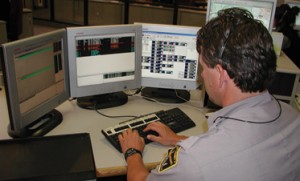9-1-1 Call of Duty
By Tom Rapp
On June 29, 2009, at approximately 1820 hrs, the Hamilton County (Ohio) Communications Center received a call via 9-1-1 from a young lady, Jenny, concerned for the safety of a friend who was serving in the U.S. Army in Saudi Arabia. This friend had called her because he had recently received word from his wife that she was leaving him. During the call, the soldier became extremely distraught, and then, suddenly, the line disconnected. Jenny repeatedly attempted to reestablish contact with him using the phone number she had, but got a busy signal. As a last resort, she called 9-1-1 looking for assistance.
I processed the call just as I would any local 9-1-1 call, trying to gather as much necessary information as I could to help the soldier and Jenny. After a short time on the phone, it became clear to me that Jenny’s information was limited, and if I was going to provide any assistance, I would have to do some legwork to fill in the blanks. Jenny provided his name, said that he was about 40 years old and that she believed he was a colonel in the Army. She also had his mailing address and a phone number.
Armed with this information, my first attempt was to make contact with someone at the phone number Jenny provided. The number, which was a local number into an Air Force base in Ohio, was forwarded to Eskan Village, Kingdom of Saudi Arabia. I reached an operator, but my attempts to explain the situation were in vain due to a fairly severe language barrier. He did not understand what I was trying to do, and he could not provide any direction concerning who to talk to regarding this situation.
I called Jenny back shortly thereafter to see if there had been any contact from the soldier. There hadn’t. I reassured her that I was making every attempt to get in touch with someone on the base to make sure he was safe.
I made several attempts to directly dial the soldier’s extension, but all attempts failed—only busy signals.
After my first contact with the base’s contracted operator, I concluded that calling back would only result in more frustration. I began searching through the many different federal phone numbers that we have on file. I began dialing military police numbers in Columbus, Ohio, Fort Knox, Ky., and Wright Patterson AFB in Dayton. These calls all met with failure, either going to an answering machine or not being answered at all. In desperation, I dialed the local number for the Secret Service and reached the on-duty agent in Chicago, Ill.
After explaining the situation, he suggested trying to get as much additional information on the soldier as possible, as well as trying to find his local command in the U.S. because it would have a representative who could contact someone directly on the base in Saudi Arabia.

Rapp used many resources, from local contacts to the Internet, to find out more information about the soldier’s identity and to contact the U.S. Army base in Saudi Arabia. (Photo Courtesy Hamilton County Comm Center )
At this point, I had enlisted the help of a co-worker who was trying to track down additional sources of information on the soldier and determined that I would once again try to contact the operator in Saudi Arabia to get through to someone in the base’s chain of command.
On calling the base and again being connected to a contracted operator, I asked for the military police and was connected to Airman Pierce. I explained the situation to Airman Pierce, stressing to him that I was only trying to make sure that the soldier was safe. I wasn’t aware of any direct threats made to the soldier or to other members on base. He was able to come up with the soldier’s cell phone number and said that he believed he was with “the 379th” on the Army side of the base. The cell phone turned out to be another dead end.
Being a veteran myself, I went to Military.com and located a member with the same name, middle initial “H,” who was an officer in the Army National Guard, stationed in Kentucky. I contacted Jenny again to verify his middle name and home state. Jenny verified that the soldier’s middle name was Hendrick and that his family was from Louisville, Ky.
My co-worker located an Army Information line in Louisville, Ky. They advised us to reestablish contact with the airman at Eskan Village and ask to speak with the unit representative for unit USA-SPT-ACT. We once again made contact with Airman Pierce. We asked to speak with a unit representative for USA-SPT-ACT, but he had no idea what we were talking about or what that unit identification referred to. I learned that Airman Pierce had only been in the country for about three weeks. He told us that he had contact information for members on the base from 2007–2008, but was unable to find anything more recent. Another dead end.
We called the original Army Information line in Louisville to attempt to gather more information, but no additional information was available. We found a number to the Kentucky National Guard on the Internet, but that line was disconnected. We tried a second number from the Internet, which went to a voice mail for a sergeant.
Running out of leads, we called the Kentucky Emergency Operations Center, which transferred us to the Kentucky National Guard. We spoke with a Sgt. Stone. We provided him with all the information we had, again stressing that we were simply trying to ensure the safety of the soldier. He reassured us that we were doing the right thing and assured us that he would try to locate any information possible on him and call us back.
At approximately 2008 hrs, Sgt. Stone called back. He was able to get a hold of someone who served with the soldier in the National Guard. He told us that he went active duty and was able to provide us two additional numbers at Fort Knox to try to get through to someone on the base. My co-worker made the call to Fort Knox, speaking with a Mr. Banks. All available information was provided to Mr. Banks, and he informed us he would check his records and call us back.
At this point, I decided to call Airman Pierce back and ask him to connect me with whoever he would call if there was a direct threat to the base. He asked if I thought the soldier represented a threat, to which I would not give an answer. I explained to the airman that I would rather err on the side of caution and roust him to make sure that he was safe rather than do nothing. Airman Pierce agreed, and after briefing the MPs on the base, they agreed also. I thanked Airman Pierce and left him and the Military Police to do what they felt was right.

With help from an airman in at Eskan Village in Saudi Arabia, Hamilton County Comm Center telecommunicators confirmed that the soldier was OK in just under three hours. (Photo Courtesy Hamilton County Comm Center)
It was approximately 2100 hrs when Airman Pierce called back to inform me they had made contact with the soldier and everything was OK. I immediately called Jenny to assure her that her friend was safe.
Looking Back
Although it was exceptionally trying, this situation has also proved to be a valuable learning tool for our organization. As an organization, we value the many assets and tools that we have at our disposal, however, a majority of them are hardware related. This situation highlighted the importance of many non-tangibles—first and foremost, information.
Most comm centers process an incredible amount of information every day. Many have access to contact information that isn’t available anywhere else—whether it be on heavy-duty construction equipment or after-hours contact information for clergy members. Agencies should take the time to review their 24-hour contact information to ensure its accuracy. The time to determine if your 24-hour number is disconnected or not really a 24-hour number is not when you need to reach someone. Second, keep in mind alternative sources of information that may be available. Although the Internet may not be able to solve your problem, it could provide valuable direction or information that will keep you pointed in the right direction.
The final lesson is to be thorough and make sure that all leads are exhausted before giving up. At many times during this incident, it would have been easy for us to become discouraged and throw in the towel. The goal was to make sure this soldier was safe. Stopping before I had done so would have been very difficult.
About the Author
Tom Rapp is supervisor II, second shift, for Hamilton County (Ohio) Communications Center. Contact him via e-mail at tom.rapp@hamilton-co.org.
Orginially published in Public Safety Communications, 76(2): 36-27, February 2010.


